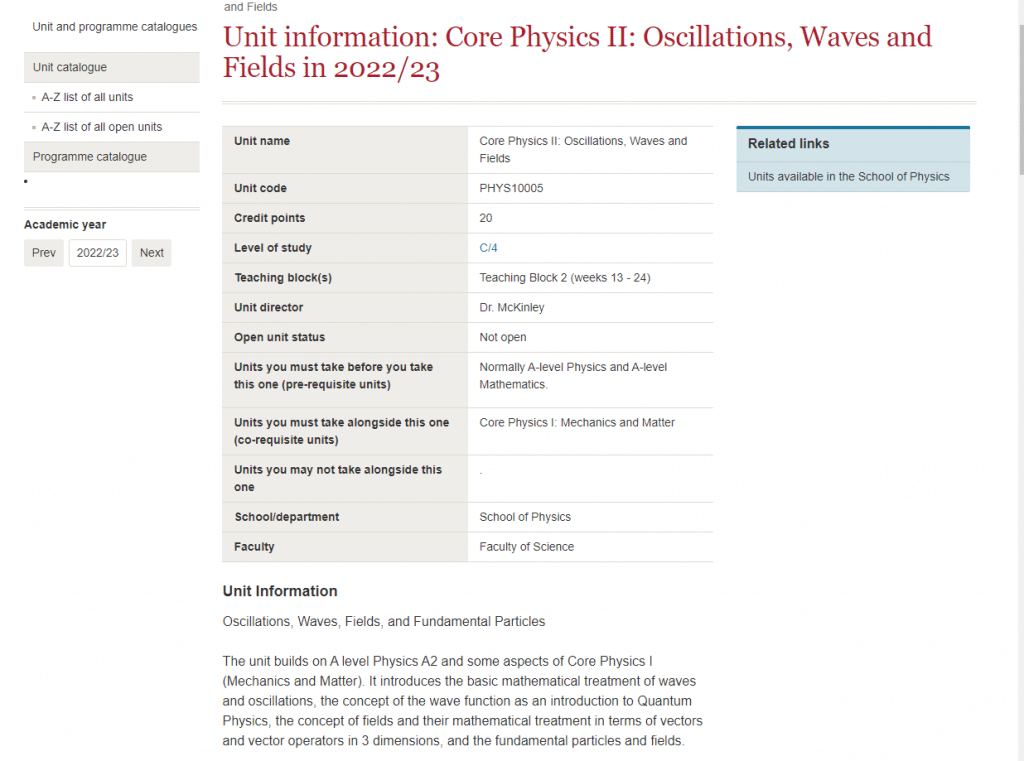Assignment-daixieTM为您提供布里斯托大学University of Bristol Oscillations, Waves and Fields PHYS10005振荡,波和场代写代考和辅导服务!
Instructions:
Physics that builds on the foundation of A level Physics A2 and Core Physics I (Mechanics and Matter). In this unit, you will learn about waves and oscillations, which are fundamental concepts in physics that can be applied to a variety of fields, such as acoustics, optics, and quantum mechanics. You will also be introduced to the concept of the wave function, which is a fundamental concept in quantum mechanics that describes the behavior of quantum particles.
In addition to waves and oscillations, the unit will cover the concept of fields and their mathematical treatment in terms of vectors and vector operators in three dimensions. Fields are an important concept in physics because they help us understand how forces are transmitted through space. By learning about fields, you will gain a deeper understanding of how the physical world works.
Finally, the unit will cover fundamental particles and fields. This includes topics such as the Standard Model of particle physics, which is a theoretical framework that describes the fundamental particles and forces in the universe. By learning about fundamental particles and fields, you will gain a deeper understanding of the building blocks of the universe and the forces that govern their behavior.

A vertical spring on which is hung a block of mass $m_1$ oscillates with angular frequency $\omega$. With an additional block of mass $m_2 \neq m_1$ added to the spring, the frequency is $\omega / 2$. What is the ratio $m_1 / m_2$ ?
We know the general formula for the angular frequency of a mass-spring system of spring constant $k$ and total mass $M_{\text {tot }}$ is
$$
\omega=\sqrt{\frac{k}{M_{\text {tot }}}} .
$$
If we have $\omega_{\text {before }}=\sqrt{k / m_1}$ and $\omega_{\text {after }}=\sqrt{k /\left(m_1+m_2\right)}$ and
$$
\omega_{\text {after }}=\frac{1}{2} \omega_{\text {before }},
$$
then we have
$$
\sqrt{\frac{k}{m_1+m_2}}=\frac{1}{2} \sqrt{\frac{k}{m_1}},
$$
or $m_1+m_2=4 m_1$ which gives us $m_1 / m_2=1 / 3$
You stop your car to pick up a member of your car pool. After she gets in, does the angular frequency $\omega$ of the oscillation due to the car’s suspension, increase, decrease or stay the same?
We can effectively take the suspension of the car to be a spring of some spring constant $k$. If $M_{\text {tot }}$ is the mass of the car then the angular frequency of the suspension is
$$
\omega_0=\sqrt{\frac{k}{M_{\mathrm{tot}}}} .
$$
If we add $m$ to the $M_{\text {total }}$ we find a new angular frequency
$$
\omega_f=\sqrt{\frac{k}{M_{\mathrm{tot}}+m}}<\sqrt{\frac{k}{M_{\mathrm{tot}}}}=\omega_0 .
$$
Therefore, the angular frequency due to the car’s suspension decreases.
Given an object suspended by a spring, which of these variables of the motion can you control by varying the initial conditions: period, amplitude, energy of the system, frequency, phase, maximum velocity, maximum acceleration
For a mass-spring system, the angular frequency is $\omega=\sqrt{k / m}$ and the period is $T=2 \pi / \omega$. Both of these quantities are fixed by the setup of the system and are therefore independent of the initial conditions. Everything else in the system is determined by the initial conditions. In particular, the motion is given by
$$
x(t)=A_0 \cos (\omega t-\phi),
$$
where $A_0=\sqrt{x_0^2+v_0^2 / \omega^2}$ and $\tan \phi=v_0 / \omega x_0$. The total energy of the system is $E=\frac{1}{2} k A_0^2$. The maximum velocity and acceleration are, respectively, $A_0 \omega$ and $A_0 \omega^2$. Thus we see that the energy of the system, the phase, the maximum velocity, and the maximum acceleration are controlled by the initial conditions.
